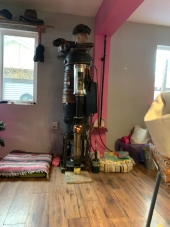








Bless your Family,
Mike
 1
1




 1
1








![Filename: BellHeaterSection.jpg
Description: [Thumbnail for BellHeaterSection.jpg]](/t/96067/a/67898/BellHeaterSection.jpg)













 1
1








 2
2




 1
1




















kelly myer wrote:The idea of pex in the mass to store and then distribute heat is an excellent idea, would also have to consider the cost of filling the system with antifreeze and keep it filled so air in pipes is not an issue. And I was looking at solutions without too many controls aside from the burn in the stove. The cabin this will be in is an open concept design so am hoping heat distribution won't be an issue. Especially if the bell spans across the few walls that will be in the structure.




Travis Johnson wrote:With hydronic heat, the pex is the cheapest part of the system, and the next cheapest part is the boiler. It is the controls that get expensive, but that is the heart of the system and where the efficiency comes from too.
By itself, water is 600 times more efficient then air, yet controls are not 600 times more expensive, so from an investment standpoint, boilers and hydronic heat are the most efficient to implement.
The one thing not cited here is that concrete can only tolerate so much heat before it starts breaking down chemiocally, that is why the water temp in radiant floor heat is pretty low. Yes the "radiator" is the entire concrete slab of the house, but enough pex must be installed so that lower temperature heat is used throughout the entire slab. Even with rebar, a suspended concrete slab that is overheated will crumble like glouten-free banana bread.
With a metering valve (plc controlled circulating pump), a rocket mass heater would be ideally suited for radiant floor heat because only warm water is required to heat the home (100-150 degree water), BUT it takes a lot of controls to get that warm water, exactly where it needs to be, to do the most good.
But if people have a dislike of concrete, just use sand. That is what I used on part of my house.
We can't change the world, we can help people change their lives.

 2
2




Some places need to be wild

|
Danger, 10,000 volts, very electric .... tiny ad:
Support permies and give beautiful gifts to gardeners: permaculture playing cards.
https://gardener-gift.com/
|






